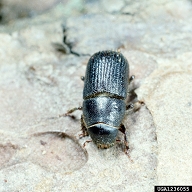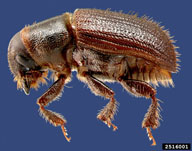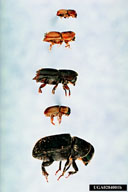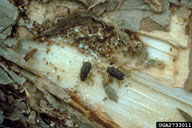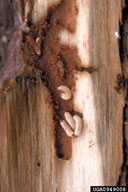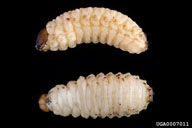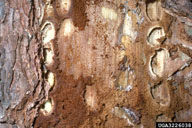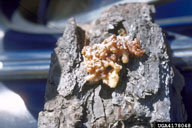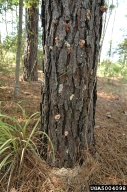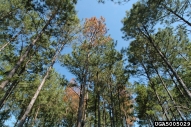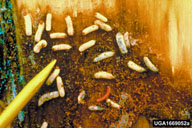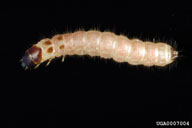Black turpentine beetle
Dendroctonus terebrans (Olivier) (Coleoptera: Curculionidae, Scolytinae)
Orientation to pest
Black turpentine beetle, Dendroctonus terebrans (Olivier), is a native, North American bark beetle that attacks various pines. Adults of this species are strongly attracted to odors of freshly cut pine stumps, where they are able to breed. In whole trees, eggs are primarily laid in the bottom 1-2 meters of the boles as well as roots of weakened trees. Eggs are laid in large oviposition galleries created by females with the help of males. Larvae feed collectively in large galleries. Pupation takes place in pupal cells constructed in the corky bark or between the bark and the wood. In the northern part of the range, adults are the overwintering stage. In southern areas, all stages may be present all year. Damage can occur in healthy trees as well as stressed trees, and damage in turpentine orchards can be severe. The black turpentine beetle is often found attacking trees in association with the southern pine beetle (Dendroctonus frontalis Zimmermann) or various species of southern pine engraver beetles (Ips spp.).
Hosts commonly attacked
Hosts of black turpentine beetle include all species of southern pines, but especially loblolly (Pinus taeda L.) and slash (Pinus elliottii Engelm.) pines. In the northern part of its range, black turpentine beetle attacks various conifers, including black (Pinus thunbergiana Franco) and pitch (Pinus rigida Miller) pines and red spruce (Picea rubens Sargent).
Distribution
This bark beetle is found in the eastern United States from Florida west to Missouri and Texas and north to coastal areas of southern New England.
Images of black turpentine beetle
| Figure 1. Adults of black turpentine beetle, Dendroctonus terebrans | Figure 2. Black turpentine beetle (bottom) is the largest or the five species of southern pine bark beetles. The other species (from top down) are Ips avulsus (Eichhoff), Ips grandicollis (Eichhoff), Ips calligraphus (Germar), and Dendroctonus frontalis Zimmermann.) | |
| Figure 3. Eggs of black turpentine beetle (white, above beetle on left) | Figure 4. Larvae of black turpentine beetle in common feeding gallery (left); larvae enlarged (right) | |
| Figure 5. Pupae of black turpentine beetle, in pupal cells, lower left | Figure 6. Pitch tubes (left) are created by the tree where black turpentine beetles bore in the tree; during mass attack, there may be many pitch tubes in the lower bole area (right) | |
| Figure 7. Dying loblolly pines infested with both Ips beetles and black turpentine beetles | Figure 8. The clerid Thanasimus dubius (red larva in lower center, left and close up on right) is a common predator of brood of black turpentine beetles | |
Important biological control agents related to this pest species
Little is known about the specific natural enemies of this species. The clerid Thanasimus dubius (Fabricius) and the trogositid Temnochila virescens (Fabricius), predatory beetles that prey on many southern pine bark beetles, are found attacking brood of black turpentine beetles.
Web links for information on black turpentine beetle
Articles
- Barras, S. J. and T. Perry 1971. Leptographium terebrantis sp. nov. associated with Dendroctonus terebrans in loblolly pine. Mycopathologia 43: 1-10.
- Foltz, J. L., E. P. Merkel, and R. C. Wilkinson. 1984. Annotated bibliography of Dendroctonus terebrans (Oliver), Ips avulsus (Eichhoff), Ips grandicollis (Germar) in the southeastern USA. Monograph No. 12. Agricultural Experiment Station, University of Florida, 47 pp.
